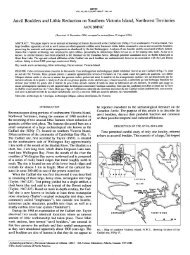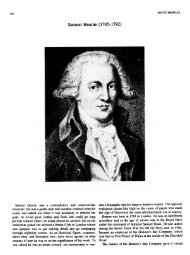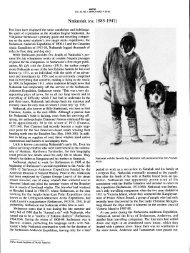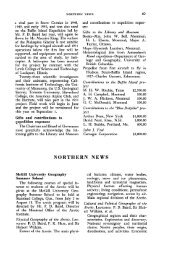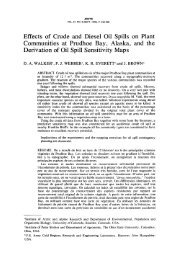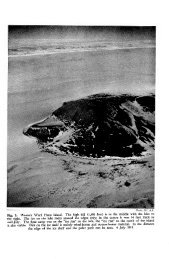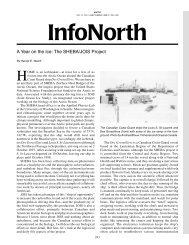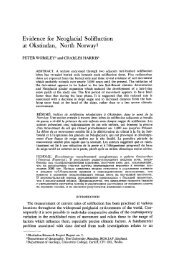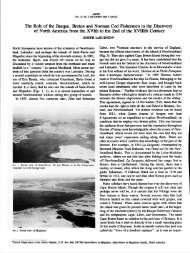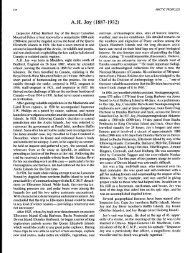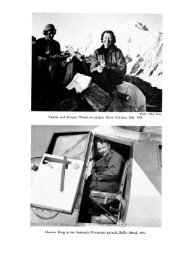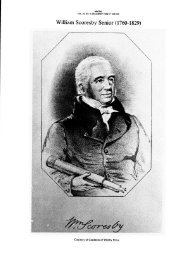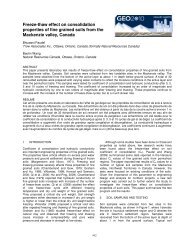To Make These Tribes Understand - AINA Publications Server
To Make These Tribes Understand - AINA Publications Server
To Make These Tribes Understand - AINA Publications Server
You also want an ePaper? Increase the reach of your titles
YUMPU automatically turns print PDFs into web optimized ePapers that Google loves.
228 • K.S. COATES and W.R. MORRISON<br />
men visiting the North country … and lastly the brutal and<br />
cowardly murder of Otto Binder and Corporal Doak, I feel<br />
it my duty, although very painful to me, to recommend<br />
most respectfully, but most earnestly, that the Law follow<br />
its course. (CDSS, 1923)<br />
At the time, no one remarked on the significance of the fact<br />
that only Alikomiak had been condemned for killing whites;<br />
Tatamigana was sentenced for killing one of his own people.<br />
This might have been taken as an example of even-handedness<br />
on the part of the government, and is perhaps the reason,<br />
though the records are silent on the point, why Tatamigana,<br />
who had not even fired the shot that killed Pugnana, though<br />
he had plotted it with Alikomiak, was also sentenced to hang.<br />
Perhaps the government wanted to make an example of him<br />
to demonstrate that the law would protect the Inuit in the same<br />
fashion as whites.<br />
The cases of Alikomiak and Tatamigana attracted a great<br />
deal of attention in the newspapers and amongst the public.<br />
The government received petitions and letters recommending<br />
clemency, both from members of the general public and<br />
from people with northern experience. The typical argument<br />
rested on the idea that the Inuit were primitive, childlike, and<br />
ignorant of the law; an undated letter from E. Maitland of<br />
Plummer, Ontario, expressed the idea eloquently:<br />
Although a woman, I am not one who favours the abolition<br />
of the death penalty … but it seems not unreasonable to<br />
sympathize with the ignorant, primitive people, standing<br />
confused and bewildered in one of our law courts, and so<br />
simple-minded and remote from the subtleties of<br />
“civilized” law proceedings that they told a straightforward<br />
tale, which practically convicted themselves.<br />
(CDSS, 1923)<br />
Wilfred Grenfell, the medical missionary, commented<br />
publicly on the case, stating that “to hang an Eskimo for<br />
murder is the same as hanging a little child … The Eskimos<br />
are an extraordinarily intelligent people … but they are totally<br />
ignorant of law and the consequences of its violation. Ethically,<br />
the Eskimo is just like a child of seven years. You would<br />
not hang a child of seven years, would you?” (Grenfell, 1923).<br />
One wonders how much he had learned about Inuit culture<br />
during his thirty years of service on the Labrador coast.<br />
Some Northerners also commented on the case, notably<br />
J.R. Lucas, Anglican Bishop of Mackenzie River, within<br />
whose diocese the murders had occurred and who had witnessed<br />
the trials, and I.O. Stringer, Bishop of the Yukon. Both<br />
made the argument that the condemned men should not be<br />
executed for breaking laws that they knew nothing about, and<br />
should instead suffer life imprisonment, but the government<br />
had heard these arguments in previous cases and was not<br />
prepared to yield to them again (CDSS, 1923). Bishop Lucas<br />
also made the point in a letter of 17 September 1922 to R.<br />
Dandurand, Acting Minister of Justice, that “it will not<br />
enhance the reputation of the White man among them, if they<br />
think that it was fear of meeting a similar fate that led them to<br />
take their countrymen away where it would be safe to kill<br />
them…the execution of these two men will jeopardize the<br />
lives of White men who may be living amongst the tribes of<br />
Eskimos whence these murderers came” (CDSS, 1923).<br />
W.D. Reeve, Bishop of <strong>To</strong>ronto, suggested corporal punishment<br />
as an alternative to death: “Imprisonment or banishment<br />
would not be adequate, but what about flogging? I am<br />
inclined to think that the application of the lash would have<br />
a greater moral and deterrent effect than anything else”<br />
(CDSS, 1923).<br />
It was suggested in the press and elsewhere that Alikomiak<br />
was only 16 years old, but the police secured a statement from<br />
a trader who had known the man for six years and swore that<br />
he was at least an adolescent when he first met him. It was also<br />
suggested that Otto Binder had started the sequence of events<br />
by stealing the wife of a local Inuit, a rumour that sparked a<br />
petition from the Hamilton Ontario Local Council of Women,<br />
who sympathized with men who had “followed their own<br />
natural light in regard to right, in avenging this transgression<br />
against home and wifehood” (CDSS, 1923). This rumour was<br />
denied by the police, who presented statements from witnesses<br />
to disprove it; and even if true, it would have had little<br />
bearing on the murder of Doak.<br />
Although the bishops and a number of others protested the<br />
sentences, the newspapers generally supported them<br />
(Morrison, 1985:160), and the government—not surprisingly<br />
given the sequence of events—refused to commute<br />
them. Accordingly, a Mounted Police patrol was sent from<br />
the northern Yukon to Herschel Island in the late fall of 1923<br />
with the news that there was to be no mercy, and the two men<br />
went stoically to the gallows on 1 February 1924. Knud<br />
Rasmussen described their last hours:<br />
one evening late in winter, while following their customary<br />
occupation of making salmon nets, they were informed<br />
that they were to be hanged next morning at three o’clock.<br />
Young Alekámiaq received the news with a smile. The<br />
other man, who was somewhat older, felt as if he was<br />
choking and asked for a glass of water; having taken a<br />
drink he too was ready to meet his fate. Just before they<br />
were to be executed they gave the wife of the police<br />
sergeant some small souvenirs carved in walrus ivory, as<br />
a sign that they bore no malice towards the police. They<br />
ascended the scaffold with great calmness and met death<br />
without fear. (Rasmussen, 1932:64)<br />
What conclusions can be drawn from this episode? The<br />
most important and the most obvious, as has been noted by<br />
other commentators (Harring, 1989; Price, 1991), is that<br />
these were clearly show trials, carefully staged for public<br />
effect. Everything about them, from the location to the<br />
sentencing, was designed to send a message that Canada’s<br />
sovereignty over the region was to be enforced. The question<br />
arises, however, for whom the show was put on. <strong>To</strong> whom<br />
was the message directed? The immediate answer would<br />
seem to be to the Inuit, but for a number of reasons this seems<br />
not to be the whole truth. It is just as likely that the



